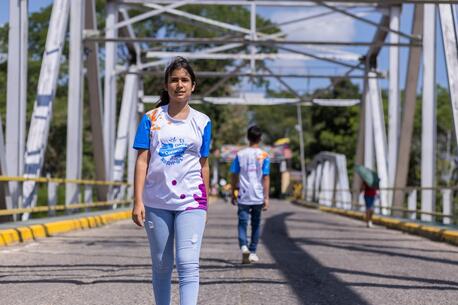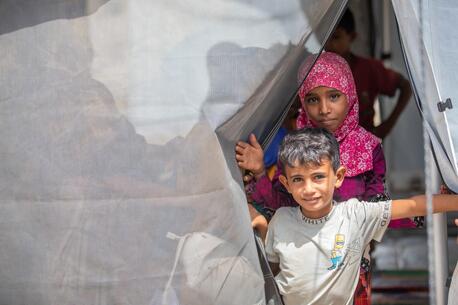
UNICEF, Sustainable Development Goals 2030 and Social Impact Investors
How the UNICEF USA Bridge Fund can help you leverage social return for children worldwide.
Christine Bosse, a Board member of the Global Impact Investing Network (GIIN), Allianz, TDC and BankNordik, argues that the world's Sustainable Development Goals 2030 (the "SDGs"), offer “… a golden opportunity [for investors]. And the people who get knowledgeable first and are interested in really getting on board in these areas will, of course, also be the ones who, in the long run, take the largest benefits.”
As a leader in implementing the SDGs for children, UNICEF promotes long-term systemic change and assesses the social return for children of all those involved in development (governments, NGO's, other UN agencies, multi-laterals, philanthropy and the private sector) across a consistent set of goals by using internationally agreed-upon metrics.
In turn, by accelerating urgent funding for UNICEF, the UNICEF USA Bridge Fund offers investors and donors the ability to leverage UNICEF’s lifesaving work for children and track the impact of their investments via concrete SDG indicators at the global, national and local levels.

To help UNICEF make progress on SDG 4 (quality education for all), the Bridge Fund accelerated grants for schools for displaced Syrian children like 5-year-old Seif-ed-Dien. ©UNICEF/UN041539
5 Things You Should Know About the SDGs
1. In 2015, 193 countries and the United Nations established 17 Sustainable Development Goals (SDGs) to create a better world by 2030 — in a broad range of areas, including poverty, hunger, health, education, climate change, gender equality, water, sanitation, energy, the environment and social justice — with an enormous impact on the lives and futures of children.
2. Unfortunately, the World Economic Forum and the U.N. Conference on Trade and Development estimate that developing countries face an annual $2.5 trillion SDG funding gap.
3. The Business and Sustainable Development Commission (BSDC) estimates that incorporating the SDGs into core growth strategies, value chain operations and policy positions could unlock economic opportunities worth at least $12 trillion a year by 2030 (more than 10 percent of global GDP) and generate up to 380 million jobs (covering more than 10 percent of the predicted labor force in 2030), mostly in developing countries.
4. The BSDC suggests that some of the primary SDG impact investing opportunities will be in four economic systems: (i) food and agriculture, (ii) cities, (iii) energy and materials and (iv) health and well-being.
5. The Global Impact Investor Network's (GIIN) recent impact investor survey revealed that 75 percent of investors report tracking their investment performance against the SDGs or that they plan to do so in the future.

The SDGs offer … a golden opportunity for investors. And the people who get knowledgeable first and are interested in really getting on board in these areas will, of course, also be the ones who, in the long run, take the largest benefits.
UNICEF and the SDGs
With ambitious goals for global health, gender and economic equality, education and the environment — and for fostering new and innovative partnerships for a better world — many SDGs intersect with UNICEF’s expertise in child health and malnutrition, psychosocial development and learning, child protection and social inclusion, girls’ empowerment, and safe water and sanitation — among just a few of UNICEF’s major initiatives.
As Henrietta M. Fore, UNICEF’s Executive Director, explains: “The SDGs embody our highest aspirations for a better world — and reflect our greatest responsibility as a global community: to provide children and young people today with the services, skills and opportunities they need tomorrow to build better futures for themselves, their families and their societies.”

UNICEF supports diphtheria, tetanus and whooping cough vaccination campaigns in conflict-torn Ukraine, demonstrating how emergency response can also contribute to progress for the SDGs for children, too. ©UNICEF/UN0201126/Maloletka
In addition to UNICEF’s comprehensive programming, the organization’s unparalleled scale — operating in 190 countries and territories — and its influence among multi-lateral organizations, governments, partner NGOs, philanthropy and the international business community, means that UNICEF is uniquely positioned to help implement SDGs that affect children and measure global progress.
The SDGs embody our highest aspirations for a better world — and reflect our greatest responsibility as a global community: to provide children and young people today with the services, skills and opportunities they need tomorrow to build better futures for themselves, their families and their societies.
SDG Progress for Children
In fact, as part of UNICEF’s SDG-related leadership, it recently released the first comprehensive assessment on the SDGs for children. Entitled “Progress for Every Child in the SDG Era,” the report offers both good news and bad.
“More than half the world’s children live in countries where we either can’t track their SDG progress, or where we can and they are woefully off-track,” said Laurence Chandy, UNICEF’s Director for the Division of Data, Research and Policy, when the report was released. “The world must renew its commitment to attaining the SDGs, starting with renewing its commitment to measuring them.” UNICEF concludes with an urgent call-to-action to governments, partners and funders involving:
- improvement of data coverage for children;
- stronger measurement of service delivery;
- more shared norms on children’s data, particularly for
- migrant and refugee children and other hard-to-reach children; and
- data-sharing that helps target the most vulnerable children with services while preserving their privacy.

Longitudinal health studies — like the one Teck Seavyong is leading here in rural Cambodia — are vital components of UNICEF’s global leadership on data for children and enable us to track progress on the SDGs. ©UNICEF/UN0222199/BROWN
UNICEF's Leadership on Data for Children
1. For 20 years, UNICEF has led global efforts to generate, analyze and share data for children and helped develop international indicators (including for the SDGs) on children’s well-being.
2. UNICEF believes that smart use of data drives better results for children.
3. UNICEF helps devise new methodologies,indicators and monitoring tools, buildstatistical capacity at the country level, develop joint estimates and harmonize monitoring across governments, NGOs and other UN agencies.
4. UNICEF has invested in pioneering work on household surveys, global data advocacy and country-led data innovation.
5. Since its inception in 1995, UNICEF’s “Multiple Indicator Cluster Surveys (MICS) — with 304 MICS conducted in more than 112 countries — has become the world’s largest source of statistically sound and internationally comparable data on women and children.
We believe that consistent, credible data about children’s situations are critical to the improvement of their lives — and indispensable to realizing the rights of every child.
Global Immunization Rates
In what otherwise might be a grim report, however, there is hope. Fortunately, progress on SDG 2, which targets hunger, and on SDG 3, which targets children’s health and well-being, has been greater and more measurable than for many other SDGs. Momentum is particularly strong for under-five child mortality, due in large part to the efforts of UNICEF and partners to aggressively address child survival and collect reliable data on program outcomes.
Immunization has driven much of the continuing reductions in child mortality. Moreover, as UNICEF’s and the World Health Organization’s (WHO) joint annual global immunization update (July 2018) makes clear: “A record 123 million infants were immunized globally in 2017,” with vaccination rates for maternal and neonatal tetanus (MNT), diphtheria, whooping cough, measles and rubella all showing marked improvement.

Targeted the most hard-to-reach children for immunization is key to reaching every child and ensuring the best health outcomes for all. Here, National Health Ministry workers transport measles, rubella and polio vaccines, via the "cold-chain" delivery system, to children in remote portions of Timor-Leste. ©UNICEF Timor-Leste/2018/BSOARES
The Bridge Fund and Immunization
The Bridge Fund has played a long-term role in supporting UNICEF’s landmark global immunization campaigns for children. Indeed, since 2011, the Bridge Fund has accelerated $200 million for UNICEF’s immunization campaigns, offering impact investors an opportunity to help save children’s lives and — with the launch of the SDGs in 2016 — evaluate progress toward key, globally measurable targets.
For example, during Fiscal Year 2018, one the Bridge Fund’s signal immunization funding accelerations involved a multi-region, $5 million bridge for Gavi, the Vaccine Alliance, an international organization that brings together the public and private sectors to help vaccinate children living in the poorest countries with new or underused vaccines for diseases such as rotavirus, which causes diarrhea, a major child killer.
The Bridge Fund’s acceleration enabled timely procurement of vaccines and cold-chain distribution equipment in approximately 22 low-income countries. The acceleration also helped ensure that immunization campaigns took place as scheduled, increasing rates of child immunization and reducing child deaths — a key SDG 3 target.

Afghanistan is one of three remaining countries where the wild polio virus is still endemic. That's why continued polio vaccination there saves children’s lives and helps make critical progress toward SDG 3 (health and well-being). ©UNICEF/UN0202777/HIBBERT
The Bridge Fund Helps Support Polio Eradication
1. In the last quarter of Fiscal Year 2018, we accelerated $10 million to support the Rotary International Foundation’s (Rotary) and UNICEF’s polio eradication campaign.
2. Our acceleration of Rotary’s grants for Afghanistan, Nigeria and Pakistan supported eradication in these three remaining polio-endemic countries, while the West and Central Africa acceleration supported maintaining polio-elimination status in these regions.
3. Accelerating funds enabled UNICEF to enter into new polio vaccination programming activities and to pre-position personnel and supplies without interruption for the upcoming year.
4. Expected outcomes include improved acceptance of vaccinators and immunization, increased vaccination rates among hard-to-reach children and in high-risk areas, more cost-effective vaccine procurement and cold-chain distribution, and further progress toward a polio-free world and SDG 3 (child health and well-being).
5. As total global polio eradication nears, the WHO estimates that paralysis of more than 16 million people will have been avoided, and an estimated 1.5 million childhood deaths will have been prevented through the systematic administration of Vitamin A during polio immunization.
6. The WHO estimates that polio eradication will have saved $40 to $50 billion, mostly in low-income countries.
As Edward G. Lloyd, UNICEF USA’s Chief Operating Officer and Chief Financial Officer, commented: “Since the Bridge Fund’s founding, we have made accelerated funding for global immunization a priority. We are deeply grateful for our investors, whose support has meant the difference between life and death for millions of children worldwide. Your continued investment will help UNICEF make further measurable SDG progress for children and forge that better world the SDGs envision for all children — no matter who they are or where they live.”
Continued investment will help UNICEF make further measurable SDG progress for children and forge that better world the SDGs envision for all children — no matter who they are or where they live.
Are you, or the organization you work for, social impact investors?
Or, are you a donor who cares about making systemic, sustainable progress for children around the world?
Top Photo: These school children in Timor-Leste benefit from UNICEF-supported education, health, nutrition and immunization initiatives, as UNICEF helps implement comprehensive SDG progress for children. "Thank you for our new school," they told the UNICEF photographer. © UNICEF/UN0227881/Helin
HOW TO HELP
There are many ways to make a difference
War, famine, poverty, natural disasters — threats to the world's children keep coming. But UNICEF won't stop working to keep children healthy and safe.
UNICEF works in over 190 countries and territories — more places than any other children's organization. UNICEF has the world's largest humanitarian warehouse and, when disaster strikes, can get supplies almost anywhere within 72 hours. Constantly innovating, always advocating for a better world for children, UNICEF works to ensure that every child can grow up healthy, educated, protected and respected.
Would you like to help give all children the opportunity to reach their full potential? There are many ways to get involved.




